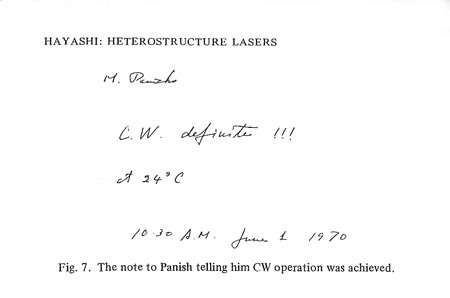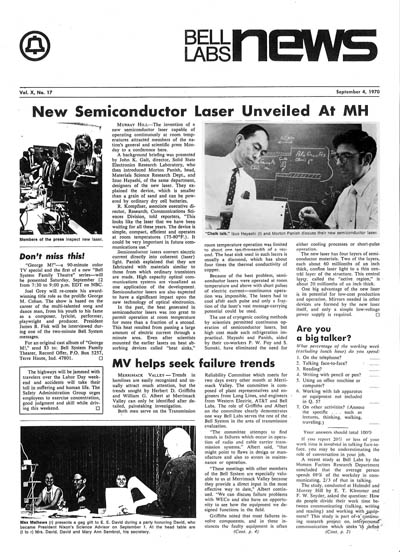11) Betting on the Room Temperature Continuous Oscillation Laser

Picture A: A research note with confirmation of the results of Hayashi and
his team
Picture B: The September 4, 1970 issue of BELL LABS News,
reporting on Hayashi’s achievement(click to enlarge)
One of the 2000 Nobel Prize winners in physics was Zhores I. Alferov of Russia, for developing a semiconductor laser in 1970 that continuously oscillated at room temperature using gallium arsenide and aluminum gallium arsenide heterostructures. However, there was a Japanese researcher who had the same achievement at the same timing. He was Izuo Hayashi of Bell Telephone Laboratories in the United States.
He went to the United States in 1963, and after completing his time at MIT,
he became a member of Bell Laboratories in 1964. Soon he started to work on
the research on semiconductor lasers in the device laboratory at Solid State
Electronic Research Division led by John Galt. At that time, the threshold
current density required for laser oscillation of gallium arsenide lasers
reached 30,000 A/cm 2 and the devices broke quickly due to heat generation.
In order to realize efficient light emission and solve the problem of heat,
they found that a double heterostructure consisting of gallium arsenide and
aluminum gallium arsenide junctions was effective. They focused especially
on the fabrication of "clean junctions".
The liquid phase epitaxy was used to grow crystals, to which his colleague
chemist Morton Panish made a contribution. The threshold current density was
lowered to 1000 A/ cm 2.
Hayashi and his colleagues confirmed this result early in the morning of June
1, 1970. It was Monday but also a holiday to remember the fallen soldiers
in war. As shown in Picture A, the research note says "Continuous oscillation
at 24 ° C is confirmed" with the date and time.
Picture B is of the September 4, 1970 issue of BELL LABS News, which reports
on the Hayashi's brilliant achievement. In the photograph, Hayashi is on the
left and Panish on the right.
(Provided by Izuo Hayashi)
